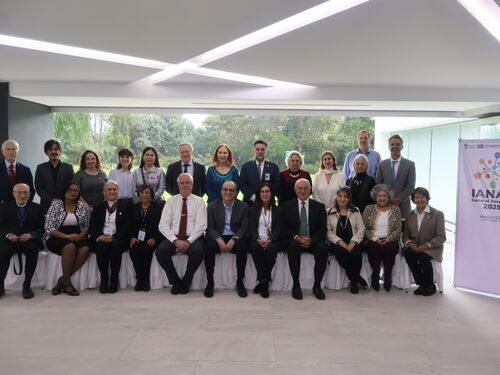Troubleshooting the Pandemic: Engineers Pitch Innovative Solutions to Help Address COVID-19
Feature Story
By Andrew Robinson
Last update July 2, 2020
While the world waits for a vaccine to prevent COVID-19 infection, international and multigenerational teams of engineers have come together through the National Academy of Engineering’s COVID-19 Call for Engineering Action to find creative solutions to problems caused by the pandemic. Their ideas aim to prevent the spread of the virus, help people most at risk, and make life easier under social distancing protocols.
“This is why the NAE was created — to bring creative engineering expertise to bear in order to address vital needs of society,” said John L. Anderson, president of the National Academy of Engineering, during the first pitch showcase of the Call for Engineering Action last week.
The Call for Engineering Action was launched to facilitate crowdsourcing and brainstorming of ideas that could protect public health and the economy during the pandemic. The initiative has attracted individuals ranging from university-level students enrolled in NAE Grand Challenges Scholars Programs to seasoned engineers and other experts. This first showcase consisted of five teams pitching their concepts to an Expert Review Committee of NAE members who provided feedback and advice on how best to advance the ideas that were presented.
First Set of Concept Presentations
Almost as important as developing a vaccine to prevent COVID-19 will be administering it to billions on a global scale. To that end, a team of professors from Carnegie Mellon University and the University of Pittsburgh are working to advance a new, more efficient way of administering vaccines. Their method uses hundreds of microneedles with dissolvable tips in a delivery patch that allows precision administration of vaccines into the highly immunologically active skin layer — rather than the traditional method of injecting vaccines into muscle through a single long needle. This new approach would be painless and use a smaller dose than traditional vaccines.
“If we are aggressive on this and we actually get the required funding and collaborations, it is feasible to…get this into commercial manufacturing within the next 12 months,” said Burak Ozdoganlar, team lead and Ver Planck Professor of Mechanical Engineering at Carnegie Mellon University.
In the meantime, one of the keys to preventing the spread of COVID-19 is testing that is both widely available and shows accurate results rapidly. A team of researchers from New York University presented their concept for a new, low-cost, and easy-to-use COVID-19 test that would instantly reveal whether a person currently has COVID-19 or has antibodies from a previous infection. The test, which would use saliva or a finger prick of blood to quickly determine the presence of COVID-19, could be self-administered at home. This innovation would be particularly beneficial in low-resource communities and countries where patients may not be able to afford the more expensive tests currently available or where there is insufficient infrastructure to support testing sites.
Early detection and monitoring of COVID-19 symptoms is essential, especially for those in higher-risk demographics. A team from the University of California, San Diego, pitched a small, bandage-like device that could remotely and continuously monitor a diagnosed patient’s key vital signs: temperature, heart rate, blood pressure, respiratory rate, and oxygen saturation. Should any of the user’s vitals measure outside of the desired range, a health care provider would be automatically alerted. This innovation would allow patients to go about their daily routines without carrying the heavy or bulky monitoring equipment that is currently commercially available.
“Those five signals can all be measured with existing commercial devices,” said Sheng Xu, team lead and assistant professor of nanoengineering at UCSD. “But [each device] can only measure one or at most two…of those signals.”
Coronavirus infection can take place even when the public is properly social distancing, particularly by touching common surfaces. An international group of students who met at the 2019 Global Grand Challenges Summit in London has been working on an idea that would eliminate the need to use one’s hand to open a door. The team’s device is a pedal that attaches to the bottom of the door with a cable going to the door’s handle. The foot-operated device pulls the door handle down, allowing the user to swing the door open without using their hands.
The coronavirus pandemic has led to severe shortages of personal protective equipment (PPE) for health care workers as well as exposed inadequate emergency inventories. For instance, the widely publicized shortage of government-approved N-95 facemasks forced many in the medical field to reuse masks and manufacturers to scramble to produce more. In addition, there is no simple proven method of disinfection for N-95 masks, presenting a contamination risk with continued use. A startup by students at the University of Southern California has come up with a concept to reduce that contamination by making masks that combine copper within N-95 filtration materials, creating continuously self-disinfecting masks. Copper has long been used for its antimicrobial properties, and this design innovation could allow those in the health care system to more safely use and, if necessary, reuse their masks, eliminating the need for routine short-term use and disposal.
More Ideas to Come
The NAE will host more pitch showcases in the coming weeks and months. In the meantime, these five teams will use guidance given by the Expert Review Committee to further their goals of bringing their COVID-19 solutions to the public, and many more concepts are developing in the NAE Call to Action incubator.
Watch the event recording here.
If you have any questions about the NAE’s COVID-19 Call for Engineering Action, please email engcovid19@nae.edu.
General interest and proposal form
More information on this initiative



